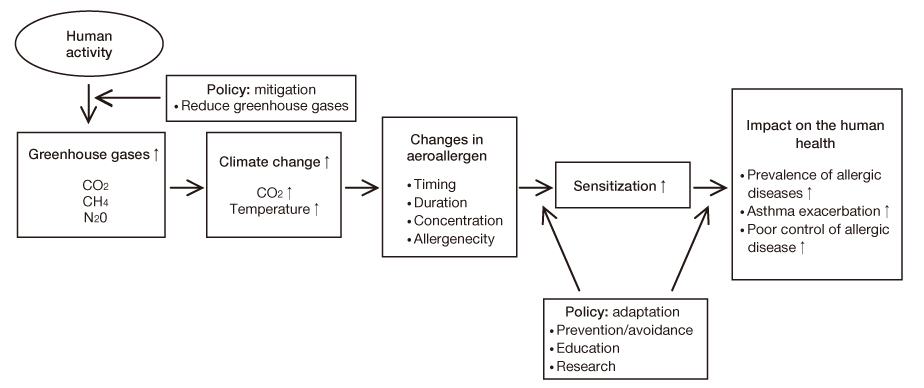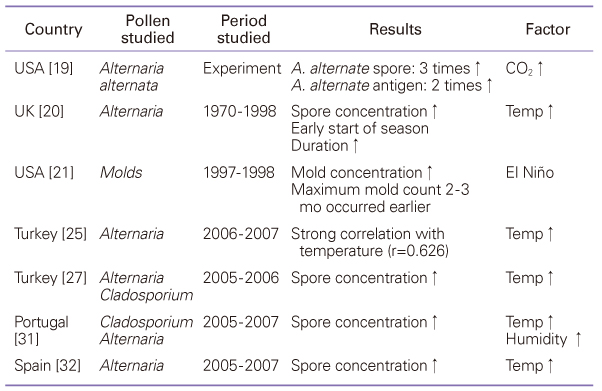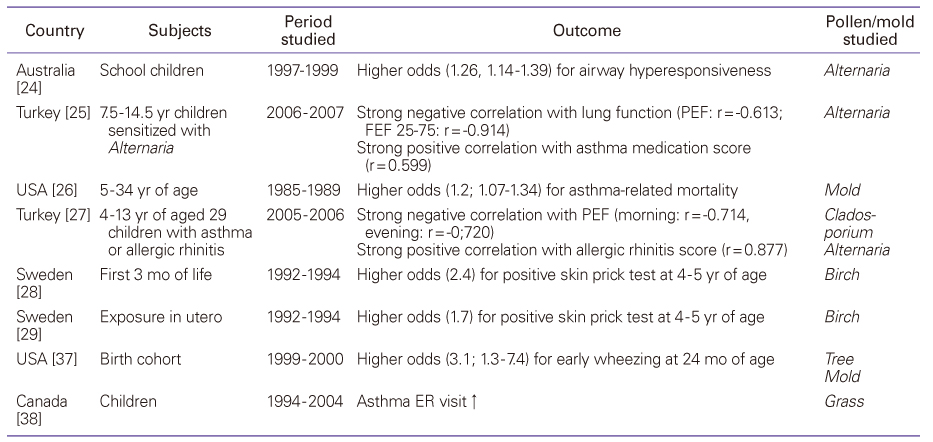 |
 |
- Search
| J Korean Med Assoc > Volume 54(9); 2011 > Article |
Abstract
The etiology of allergic diseases has been considered multi-factorial, comprising genetic, epigenetic, developmental, and environmental factors, as well as their complex interactions. The rising prevalence of allergic disease in recent decades could be explained by changes in environmental factors rather than genetic factors. Climate change has many significant impacts on aeroallergens such as pollen and mold. Therefore, climate changes are considered to be a key environmental factor affecting not only the prevalence but also the severity of allergic disease. In addition, these environmental factors might be more important for young children than for adults. While the concept that environmental factors including climate change would affect the characteristics of allergic disease is generally accepted, it is not enough to explain the mechanisms of the increase in the prevalence and severity of allergic diseases. Nevertheless, evidence exists that climate change has spurred changes in aeroallergens such as pollen and outdoor fungi, and that these changes are associated with the increased incidence of pediatric allergic disease.
References
1. Miller RL, Ho SM. Environmental epigenetics and asthma: current concepts and call for studies. Am J Respir Crit Care Med 2008;177:567-573.
2. The Core Writing Team. In: Pachauri RK, Reisinger A, editor. Climate change 2007: synthesis report. Contribution of Working Groups I, II, and III to the Fourth Assessment Report of the Intergovernmental Panel on Climate Change 2008;Geneva: Intergovernmental Panel on Climate Change. 104.
3. Beggs PJ. Adaptation to impacts of climate change on aeroallergens and allergic respiratory diseases. Int J Environ Res Public Health 2010;7:3006-3021.
4. Ahn K, Kim J, Kwon HJ, Chae Y, Hahm MI, Lee KJ, Park YM, Lee SY, Han M, Kim WK. The prevalence of symptoms of asthma, allergic rhinoconjunctivitis, and eczema in Korean children: Nationwide cross-sectional survey using complex sampling design. J Korean Med Assoc 2011;54:769-778.
5. Endangerment and cause or contribute findings for greenhouse cases under section 202(a) of the Clean Air Act. Volume 9: Endangerment fin-ding [Internet]. US Environmental Protection Agency cited 2011 Jul 20. US Environmental Protection Agency. Available from: http://www.epa.gov/climatechange/endangerment/downloads/EndangermentFinding_Health.pdf
6. Beggs PJ. Impacts of climate change on aeroallergens: past and future. Clin Exp Allergy 2004;34:1507-1513.
7. Ziska L, Knowlton K, Rogers C, Dalan D, Tierney N, Elder MA, Filley W, Shropshire J, Ford LB, Hedberg C, Fleetwood P, Hovanky KT, Kavanaugh T, Fulford G, Vrtis RF, Patz JA, Portnoy J, Coates F, Bielory L, Frenz D. Recent warming by latitude associated with increased length of ragweed pollen season in central North America. Proc Natl Acad Sci U S A 2011;108:4248-4251.
8. Emberlin J, Detandt M, Gehrig R, Jaeger S, Nolard N, Rantio-Lehtimaki A. Responses in the start of Betula (birch) pollen seasons to recent changes in spring temperatures across Europe. Int J Biometeorol 2002;46:159-170.
9. Teranishi H, Katoh T, Kenda K, Hayashi S. Global warming and the earlier start of the Japanese-cedar (Cryptomeria japonica) pollen season in Toyama, Japan. Aerobiologia 2006;22:90-94.
10. van Vliet AJ, Overeem A, De Groot RS, Jacobs AF, Spieksma FT. The influence of temperature and climate change on the timing of pollen release in the Netherlands. Int J Climatol 2002;22:1757-1767.
11. Yli-Panula E, Fekedulegn DB, Green BJ, Ranta H. Analysis of airborne betula pollen in Finland; a 31-year perspective. Int J Environ Res Public Health 2009;6:1706-1723.
12. Frei T, Gassner E. Climate change and its impact on birch pollen quantities and the start of the pollen season an example from Switzerland for the period 1969-2006. Int J Biometeorol 2008;52:667-674.
13. Ziska LH, Gebhard DE, Frenz DA, Faulkner S, Singer BD, Straka JG. Cities as harbingers of climate change: common ragweed, urbanization, and public health. J Allergy Clin Immunol 2003;111:290-295.
14. Rogers CA, Wayne PM, Macklin EA, Muilenberg ML, Wagner CJ, Epstein PR, Bazzaz FA. Interaction of the onset of spring and elevated atmospheric CO2 on ragweed (Ambrosia artemisiifolia L.) pollen production. Environ Health Perspect 2006;114:865-869.
15. Singer BD, Ziska LH, Frenz DA, Gebhard DE, Straka JG. Increasing amb a 1 content in common ragweed (Ambrosia artemisiifolia) pollen as a function of rising atmospheric CO2 concentration. Funct Plant Biol 2005;32:667-670.
16. Tashpulatov AS, Clement P, Akimcheva SA, Belogradova KA, Barinova I, Rakhmawaty FD, Heberle-Bors E, Touraev A. A model system to study the environment-dependent expression of the Bet v 1a gene encoding the major birch pollen allergen. Int Arch Allergy Immunol 2004;134:1-9.
17. Hjelmroos M, Schumacher MJ, Van Hage-Hamsten M. Heterogeneity of pollen proteins within individual Betula pendula trees. Int Arch Allergy Immunol 1995;108:368-376.
18. Green BJ, Tovey ER, Sercombe JK, Blachere FM, Beezhold DH, Schmechel D. Airborne fungal fragments and allergenicity. Med Mycol 2006;44:Suppl 1. S245-S255.
19. Wolf J, O'Neill NR, Rogers CA, Muilenberg ML, Ziska LH. Elevated atmospheric carbon dioxide concentrations amplify Alternaria alternata sporulation and total antigen production. Environ Health Perspect 2010;118:1223-1228.
20. Corden JM, Millington WM. The long-term trends and seasonal variation of the aeroallergen Alternaria in Derby, UK. Aerobiologia 2001;17:127-136.
21. Freye HB, King J, Litwin CM. Variations of pollen and mold concentrations in 1998 during the strong El Niño event of 1997-1998 and their impact on clinical exacerbations of allergic rhinitis, asthma, and sinusitis. Allergy Asthma Proc 2001;22:239-247.
22. D'Amato G, Cecchi L, Bonini S, Nunes C, Annesi-Maesano I, Behrendt H, Liccardi G, Popov T, van Cauwenberge P. Allergenic pollen and pollen allergy in Europe. Allergy 2007;62:976-990.
23. Cecchi L, D'Amato G, Ayres JG, Galan C, Forastiere F, Forsberg B, Gerritsen J, Nunes C, Behrendt H, Akdis C, Dahl R, Annesi-Maesano I. Projections of the effects of climate change on allergic asthma: the contribution of aerobiology. Allergy 2010;65:1073-1081.
24. Downs SH, Mitakakis TZ, Marks GB, Car NG, Belousova EG, Leüppi JD, Xuan W, Downie SR, Tobias A, Peat JK. Clinical importance of Alternaria exposure in children. Am J Respir Crit Care Med 2001;164:455-459.
25. Kilic M, Ufuk Altintas D, Yilmaz M, Guneşer Kendirli S, Bingol Karakoc G, Taskin E, Ceter T, Pinar NM. The effects of meteo-rological factors and Alternaria spore concentrations on child-ren sensitised to Alternaria. Allergol Immunopathol (Madr) 2010;38:122-128.
26. Targonski PV, Persky VW, Ramekrishnan V. Effect of environmental molds on risk of death from asthma during the pollen season. J Allergy Clin Immunol 1995;95:955-961.
27. Inal A, Karakoc GB, Altintas DU, Pinar M, Ceter T, Yilmaz M, Kendirli SG. Effect of outdoor fungus concentrations on symptom severity of children with asthma and/or rhinitis monosensitized to molds. Asian Pac J Allergy Immunol 2008;26:11-17.
28. Kihlstrom A, Lilja G, Pershagen G, Hedlin G. Exposure to birch pollen in infancy and development of atopic disease in childhood. J Allergy Clin Immunol 2002;110:78-84.
29. Kihlstrom A, Lilja G, Pershagen G, Hedlin G. Exposure to high doses of birch pollen during pregnancy, and risk of sensitization and atopic disease in the child. Allergy 2003;58:871-877.
30. Kihlstrom A, Lilja G, Pershagen G, Hedlin G. Maternal pollen allergy may be more important than birch pollen exposure during pregnancy for atopic airway disease in the child. Pediatr Allergy Immunol 2004;15:497-505.
31. Oliveira M, Ribeiro H, Delgado JL, Abreu I. The effects of meteorological factors on airborne fungal spore concentration in two areas differing in urbanisation level. Int J Biometeorol 2009;53:61-73.
32. Reyes ES, de la Cruz DR, Merino ME, Sanchez JS. Meteorological and agricultural effects on airborne Alternaria and Cladosporium spores and clinical aspects in Valladolid (Spain). Ann Agric Environ Med 2009;16:53-61.
33. Kim CW, Lee JH, Jung HW, Choi SR, Cheong JW, Park JW, Hong CS. Changing patterns of skin reactivity to inhalant allergens in asthmatic patients. J Asthma Allergy Clin Immunol 2001;21:205-215.
34. Oh JW. Development of pollen concentration prediction models. J Korean Med Assoc 2009;52:579-591.
35. Peden D, Reed CE. Environmental and occupational allergies. J Allergy Clin Immunol 2010;125:2 Suppl 2. S150-S160.
36. Heinrich J. Influence of indoor factors in dwellings on the development of childhood asthma. Int J Hyg Environ Health 2011;214:1-25.
37. Harley KG, Macher JM, Lipsett M, Duramad P, Holland NT, Prager SS, Ferber J, Bradman A, Eskenazi B, Tager IB. Fungi and pollen exposure in the first months of life and risk of early childhood wheezing. Thorax 2009;64:353-358.
38. Heguy L, Garneau M, Goldberg MS, Raphoz M, Guay F, Valois MF. Associations between grass and weed pollen and emergency department visits for asthma among children in Montreal. Environ Res 2008;106:203-211.
39. Kinney PL. Climate change, air quality, and human health. Am J Prev Med 2008;35:459-467.
- TOOLS










